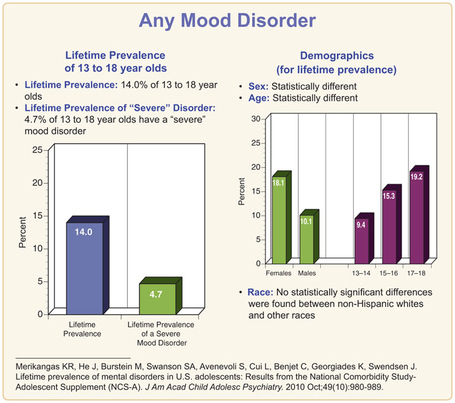2) Most people with depression don't get the care they need
According to NIMH, 50.9 percent of adults with mood disorders receive treatment of some kind. But only 19.6 percent of those people received what NIMH defines as minimally adequate treatment.
What it means for treatment to be minimally adequate varies from disorder to disorder; for major depression, it is defined as receiving an antidepressant or mood stabilizer prescription for at least 30 days and going to at least four psychiatric appointments, or, in lieu of drug treatment, at least eight therapy sessions of least a half hour each. People with bipolar disorder are slightly less likely to receive treatment.
3) Mood disorders are common with children too
14 percent of 13 to 18 year olds have a mood disorder. They are more common the older teens get, and significantly more common among young women:
(NIMH)
While major depression can manifest at early ages, bipolar disorder most commonly emerges among young adults.
4) Depression is treatable
It really, truly is.
Many, many studies have found that cognitive-behavioral therapy (CBT) is effectivewith mood disorders, particular major depression. CBT focuses on identifying negative thought patterns — exaggerating negatives, ignoring positives, etc. — and working to replace them.
Psychodynamic therapy, which is closer to traditional Freudian psychoanalysis and devotes more time to exploring the unconscious, also has some evidence supporting it, though some scholars dispute its effectiveness.
The evidence surrounding antidepressant drugs is more mixed, with some arguing that they, and in particular selective serotonin reuptake inhibitors (SSRIs), the most common kind of antidepressant, perform no better than a placebo. Other researchers haveconducted reviews with more promising findings, and there are some studiessuggesting that severely depressed people are likelier to respond well to medication.
Overall, the National Alliance for Mental Illness's (NAMI) medical director, Kenneth Duckworth, estimates that about 70-80 percent of patients with major depression respond to treatment. But everyone's depression reacts to treatment differently, and if initial treatment fails, it's possible that a different set of medications or therapeutic techniques would perform better. There's also some evidence that aerobic exercise can be an effective treatment for depression.
In extreme cases of severe depression where multiple treatment approaches have failed, techniques like vagus nerve stimulation — wherein a small device is implanted into your chest and sends electrical pulses to the vagus nerve in your neck — or electroconvulsive therapy can help. Very preliminary trials have suggested that deep brain stimulation could work in some treatment-resistant patients as well.


No comments:
Post a Comment